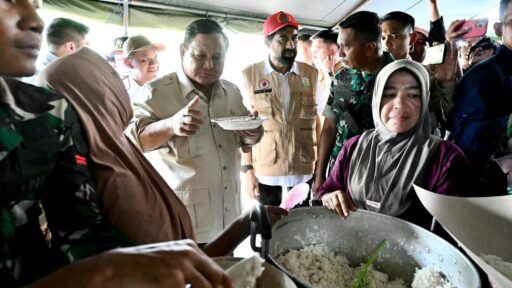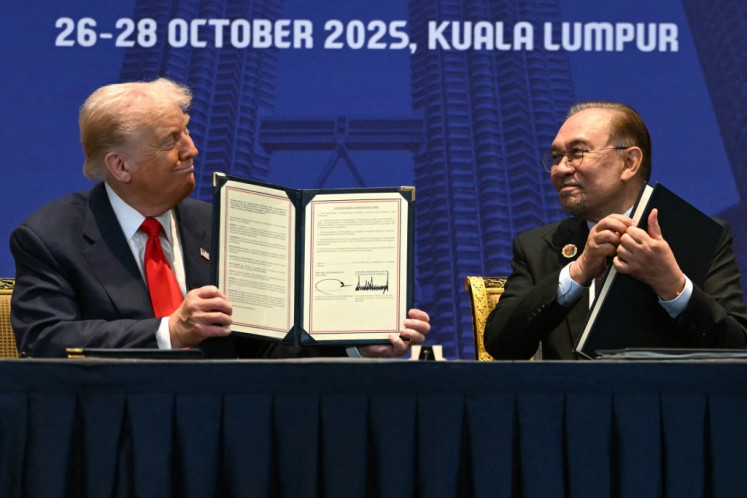Popular Reads
Top Results
Can't find what you're looking for?
View all search resultsPopular Reads
Top Results
Can't find what you're looking for?
View all search resultsVolcanoes and sacred fish in Samoa
Sanctuary: Turtle pools dot the wetlands area in Satoalepai village, Savaiâi Island
Change text size
Gift Premium Articles
to Anyone
Sanctuary: Turtle pools dot the wetlands area in Satoalepai village, Savai'i Island.
It happened more than a century ago, but the stories passed down by ancestors are as vivid as the day when Mount Matavanu first came into existence.
'When the eruption occurred, it didn't just explode once, the lava flowed for six years,' Elina Faasootauloa of Saleaula village on the central South Pacific Island state of Samoa recounted. 'Afterward, there was nothing, no trees, from here all the way to the sea.'
Today, Saleaula is a community of about 600 people on the northeast coast of Savai'i, the largest island in Samoa, which is located northeast of Fiji and near the Pacific Ring of Fire.
Known for its unspoiled rainforests and coastlines, it is also home to about 43,000 people, or a quarter of the country's population, who mainly live by agriculture and fishing.
Now as you approach the village along the coastal road the view changes from palm-tree lined beaches to a barren blackened land that extends to the white-capped ocean waves on the horizon.
There was no warning in August, 1905, when the earth parted and molten magma burst into the sky. Soon a crater formed and lava spilled over the rim, spreading to the north through a deep river valley to a flat coastal plain and eventually into the sea.
For over half a decade the lava flowed until it covered 76 square kilometers comprising farmland, five villages, a lagoon and coral reefs off the coast.
Yet miraculously, no one died.
'It happened very slowly and for a long time, so people had a lot of time to pack their things and move away. Most of the journey was on foot because it wasn't like nowadays with so many cars,' Faasootauloa explained.
Many believe villagers' lives were protected by ancestral spirits, but those who saw their homes buried left Savai'i and never returned, eventually resettling on nearby Upolu Island.
For the past 40 years, the Lava Fields ecotourism site has been managed by the Saleaula Women's Committee and with a small admission fee visitors are guided on a tour of the main sights, a ruined church and the Virgin's Grave.
The former village church is now surrounded by a shaded oasis created by trees that have re-grown through cracks in the hardened ground. But the sun now penetrates the interior, as the roof, which collapsed, is buried under a rock-like formation of lava, its swirling movement frozen in time.
Church ruined: The ruined church is a featured sight on the Lava Fields at Saleaula village on Savai'i Island, Samoa
Further along the tour path, a gaping hole in the lava field reveals an unmarked grave framed with brightly colored vegetation.
'In Samoa graves are kept near the family's house, so this area had houses before and there were graves all over the place. All of them are covered now by the lava, but this one was saved,' my guide said.
The grave, which contains the remains of a daughter of a former village high chief, is an enigma because the lava flowed around, but never covered it.
'In those times an unmarried woman was a very important lady in the village. We don't know the reason why she died, but she died unmarried and pure, and that is why she is called a virgin,' Faasootauloa said. 'We believe she was saved in God's heaven.'
Then, without a sign, the eruption stopped in 1911, but it was another 70 years before people returned to live in the affected area. The new residents have come from further along the coast where rising seas, not lava, have threatened their homes. For them, the rock-like ground is safer than the disappearing coastline believed to be caused by climate change.
Preserving and communicating the stories of Mount Matavanu's eruption is also a way for rural families to earn a sustainable income. Lava field earnings have helped fund a new school building, housing and roads in Saleaula.
This is also the case for Mataia I Su'e and his family in the next village of Satoalepai, which can be reached by a walk along the coastal road.
In the 1990s, they started developing an attraction where visitors can interact with green sea turtles, a species commonly found in Samoan waters. Now more than 20 turtles live in the large pool they have constructed in a wetlands area.
'We usually buy them from fishermen in the district, as they often catch them in fishing nets,' Sosefina, Mataia I Su'e's daughter, explained.
'There are people who use their shells to make jewelry to sell at the market, so that's why we bring them here and feed them for a year. When they become bigger we release them back to the ocean,' she continued.
From a thatched hut by the side of the pool, visitors can feed the turtles, which are herbivores, with slices of pawpaw and taro leaves, and more closely experience their gentle nature by swimming alongside them in the water.
Green turtles, named after the color of their cartilage and fat, mostly inhabit tropical waters and are known for long ocean migrations between hatching and feeding grounds of up to 4,000 kilometers.
In Samoa, sea turtles are traditionally called I'a sa, or sacred fish, and are believed to guide lost fishermen to land, according to local stories.
Playing around: Visitors can feed and swim with green sea turtles in Satoalepai village, Savai'i Island.
However, their worldwide survival is threatened by over-exploitation for their skin, shells and eggs, as well as marine pollution, habitat loss and boat injuries. Thus, green turtles are now classified as endangered on the International Union for Conservation of Nature (IUCN) Red List of Threatened Species.
The 'Swimming with Turtles' sight is not part of a conservation program and the family receives no external funding and support, but their modest earnings have been used to gradually enlarge the turtle pool and basic visitor facilities.
In a small way, Sosefina hopes that they are encouraging people to appreciate these special sea creatures and providing fishermen with incentive to save some from the market trade.
' Photos by Catherine Wilson













